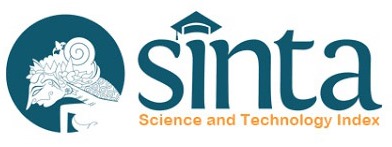Perbandingan Kinerja Ekstraksi Fikobiliprotein dari Spirulina platensis Melalui Pengadukan dan Freezing-Thawing
Abstract
Fikobiliprotein terdiri dari fikosianin, allofikosianin, dan fikoeritrin, merupakan komponen bioaktif yang terdapat pada Spirulina platensis (SP), berfungsi sebagai antioksidan dan antikanker. Metode ekstraksi secara pengadukan dan freezing-thawing dipilih karena sederhana, dan paling mudah untuk diterapkan pada skala industri. Penelitian ini membandingkan kinerja secara pengadukan dan freezing thawing pada ekstraksi fikobiliprotein (PBP) dari SP dengan solven air suling. Variabel yang diteliti adalah waktu pengadukan (1-30 menit), perbandingan solven terhadap biomassa (10-200 mL/g), waktu pembekuan (1-16 hari), serta kombinasi antara waktu pengadukan dan pembekuan. SP segar dan kering diperoleh dari CV. Paring Spirulina, Maguwoharjo, Sleman, Yogyakarta. SP segar (5 g) ditambah air suling (10-50 mL), diaduk dengan pengaduk magnetik (300 rpm), ekstraksi, dan penyaringan vakum. Filtrat yang dihasilkan diukur absorbansinya menggunakan spektrofotometer pada panjang gelombang 562, 615, dan 652 nm. SP kering (0,5 hingga 5,0 g) ditambah air suling, lalu diaduk seperti prosedur pada SP basah. Metode freezing-thawing dengan pengadukan dimulai dengan pembekuan SP, dilanjutkan dengan thawing, pengadukan, dan penyaringan vakum. Waktu pengadukan 1-5 menit (tanpa pembekuan) memberikan hasil PBP 10,39±0,44 mg/g SP kering. Waktu pembekuan 16 hari (dengan atau tanpa pengadukan) memberikan hasil PBP yang relatif tinggi, yaitu 68,15 ± 2,89 mg/g SP kering. Perbandingan solven terhadap biomassa (S/B) optimum pada 100 mL/g SP kering. Aktivitas antioksidan PBP yang ditunjukkan dengan nilai IC50 adalah 47,19 ± 0,04 mg/L (dari SP segar), dan 42,63 ± 0,08 mg/L (dari SP kering) pada kondisi ekstraksi yang optimum.
Abstract
Phycobiliprotein consisting of phycocyanin, allophycocyanin, and phycoerythrin, is a bioactive component found in Spirulina platensis (SP), which functions as an antioxidant and anticancer. Stirring and freezing-thawing were chosen as the extraction methods due to simple and easy to apply on an industrial scale. This study compared the stirring and freezing-thawing performance in extracting phycobiliprotein (PBP) from SP with distilled water as solvent. The variables studied were stirring time (1-30 minutes), solvent-to-biomass ratio (10-200 mL/g), freezing time (1-16 days), and the combination of stirring and freezing time. Fresh and dry SP obtained from CV. Paring Spirulina, Maguwoharjo, Sleman, Yogyakarta. Fresh SP (5 g) was added with distilled water (10-50 mL), stirred with a magnetic stirrer (300 rpm), extraction, and vacuum filtering. The absorbance of the filtrate was measured using a spectrophotometer at a wavelength of 562, 615, and 652 nm. Dry SP (0.5 to 5.0 g) was added with distilled water, then stirred like the procedure for wet SP. The freezing-thawing and stirring method began with SP freezing, followed by thawing, stirring, and vacuum filtering. Stirring for 1-5 minutes (without freezing) obtained PBP of 10.39 ± 0.44 mg/g dry SP. Freezing time of 16 days (with or without stirring) obtained relatively high PBP yields, namely 68.15 ± 2.89 mg/g dry SP. The optimum solvent ratio to biomass (S/B) was 100 mL/g dry SP. The antioxidant activity of PBP at the optimum condition, as indicated by the IC50 value, was 47.19 ± 0.04 mg/L (from fresh SP) and 42.63 ± 0.08 mg/L (from dry SP).
Keywords
Full Text:
PDF (Bahasa Indonesia)References
Abdullah, N.A., Zullkiflee, N., Zaini, S.N.Z., Taha, H., & Usman, A. (2020). Phytochemicals, mineral contents, antioxidants, and antimicrobial activities of propolis produced by Brunei stingless bees Geniotrigona thoracica, Heterotrigona itama, and Tetrigona binghami. Saudi Journal of Biological Sciences, 27, 2902–2911.
Agustini, T.W., Suzery, M, Sutrisnanto, D., Ma’ruf, W.F, & Hadiyanto. (2015). Comparative Study of Bioactive Substances Extracted from Fresh and Dried Spirulina sp. Procedia Environmental Sciences, 23, 282-289.
Chia, S. R., Chew, K. W., Show, P. L., Xia, A., Ho, S. H., & Lim, J. W. (2019). Spirulina platensis based biorefinery for the production of value-added products for food and pharmaceutical applications. Bioresource Technology, 289(June), 121727. https://doi.org/10.1016/j.biortech.2019.121727
Dewati, P.R., Rochmadi, Rohman, A., & Budiman, A. (2020). A Preliminary Study of Extraction and Purification Processes of Astaxanthin from Haematococcus pluvialis as Natural Antioxidant. Material Science and Engineering, 778, 012032.
Dombrovsky, L.A., Nenarokomova, N.B., Tsiganov, D.I., & Zeigarnik, Y.A. (2015). Modeling of Repeating Freezing of Biological Tissues and Analysis of Possible Microwave Monitoring of Local Regions of Thawing. International Journal of Heat and Mass Transfer, 89, 894–902.
Fithriani, D., Amini, S., Melanie, S., & Susilowati, R. (2015). Uji Fitokimia, Kandungan Total Fenol dan Aktivitas Antioksidan Mikroalga Spirulina sp., Chlorella sp., dan Nannochloropsis sp. Jurnal Pascapanen Dan Bioteknologi Kelautan Dan Perikanan, 10(2), 101. https://doi.org/10.15578/jpbkp.v10i2.270
Hsieh-Lo, M., Castillo, G., Ochoa-Becerra, M. A., & Mojica, L. (2019). Phycocyanin and phycoerythrin: Strategies to improve production yield and chemical stability. Algal Research, 42(June), 101600. https://doi.org/10.1016/j.algal.2019.101600
Huriyah, S. B., Setyaningsih, I., & Trilaksani, W. (2019). Formulasi Tablet Suplemen Spirulina yang Diperkaya dengan Virgin Fish Oil Mata Tuna (Thunnus sp.). Jurnal Pascapanen Dan Bioteknologi Kelautan Dan Perikanan, 14(2), 117. https://doi.org/10.15578/jpbkp.v14i2.606
Mulot, V., Benkhelifa, H., Pathier, D., Ndoye, F., & Flick, D. (2019). "Experimental and numerical characterization of food dehydration during freezing", Journal of Food Engineering, 263, 13–24.
Murtini, J.T., Triwibowo, R., Indriati, N., & Ariyani, F. (2010). Uji Toksisitas Subkronik Spirulina platensis secara in-vivo. Jurnal Pascapanen Dan Bioteknologi Kelautan Dan Perikanan, 5(2), 123-133. https://doi.org/ 10.15578/jpbkp.v5i2.416
Notonegoro, H., Setyaningsih, I., & Tarman, K. (2018). Kandungan Senyawa Aktif Spirulina platensis yang Ditumbuhkan pada Media Walne dengan Konsentrasi NaNO3 Berbeda. Jurnal Pascapanen Dan Bioteknologi Kelautan Dan Perikanan, 13(2), 111. https://doi.org/10.15578/jpbkp.v13i2.555
Pan-utai, W., & Iamtham, S. (2019). Extraction, purification and antioxidant activity of phycobiliprotein from Arthrospira platensis. Process Biochemistry, 82, 189–198.
Rodrigues, R. D. P., de Castro, F. C., Santiago-Aguiar, R. S. de, & Rocha, M. V. P. (2018). Ultrasound-assisted extraction of phycobiliproteins from Spirulina (Arthrospira) platensis using protic ionic liquids as solvent. Algal Research, 31(January), 454–462. https://doi.org/10.1016/j.algal.2018.02.021
Rodrigues, R.D.P., de Lima, P.F., de Santiago-Aguiar, R.S., & Rocha, M.V.P. (2019). Evaluation of protic ionic liquids as potential solvents for the heating extraction of phycobiliproteins from Spirulina (Arthrospira) platensis. Algal Research, 38, 101391.
Rodrigues, R. D. P., Silva, A. S. e., Carlos, T. A. V., Bastos, A. K. P., de Santiago-Aguiar, R. S., & Rocha, M. V. P. (2020). Application of protic ionic liquids in the microwave-assisted extraction of phycobiliproteins from Arthrospira platensis with antioxidant activity. Separation and Purification Technology, 252(May). https://doi.org/10.1016/j.seppur.2020.117448
Soni, R. A., Sudhakar, K., & Rana, R. S. (2017). Spirulina – From growth to nutritional product: A review. Trends in Food Science and Technology, 69, 157–171. https://doi.org/10.1016/j.tifs.2017.09.010
Sulistiawati, E. (2022). Studi Ekstraksi Komponen Bioaktif Antioksidan (Phycocyanin) dari Spirulina platensis dengan Perlakuan Awal Freezing-Thawing. Dissertasi, Universitas Gadjah Mada, Yogyakarta.
Sulistiawati, E., Rochmadi, R., Hidayat, M., & Budiman, A. (2023). Enhancement of Phycocyanin Extraction from Dry Spirulina platensis Powder by Freezing-Thawing Pre-treatment. International Journal of Technology, 14(4), pp.780-790.
Tavanandi, H. A., Mittal, R., Chandrasekhar, J., & Raghavarao, K. S. M. S. (2018). Simple and efficient method for extraction of C-Phycocyanin from dry biomass of Arthospira platensis. Algal Research, 31(February), 239–251. https://doi.org/10.1016/j.algal.2018.02.008
Wang, F., Yu, X., Cui, Y., Xu, L., Huo, S., Ding, Z, Hu, Q, Xie, W., Xiao, H., & Zhang, D. (2023). Efficient extraction of phycobiliproteins from dry biomass of Spirulina platensis using sodium chloride as extraction enhancer. Food Chemistry, 406, 135005.
Yuan, D., Yao, M., Wang, L., Li, Y., Gong, Y., & Hu, Q. (2019). Effect of recycling the culture medium on biodiversity and population dynamics of bio-contaminants in Spirulina platensis mass culture systems. Algal Research, 44(June), 101718. https://doi.org/10.1016/j.algal.2019.101718
Zheng, J. X., Yin, H., Shen, C. C., Zhang, L., Ren, D. F., & Lu, J. (2020). Functional and structural properties of spirulina phycocyanin modified by ultra-high-pressure composite glycation. Food Chemistry, 306(June 2019), 125615. https://doi.org/10.1016/j.foodchem.2019.125615
DOI: https://doi.org/10.15578/jpbkp.v18i1.912
Refbacks
- There are currently no refbacks.
JPBKP adalah Jurnal Ilmiah yang terindeks :
ISSN : 1907-9133(print), ISSN : 2406-9264(online)
This work is licensed under a Creative Commons Attribution-NonCommercial-ShareAlike 4.0 International License.








